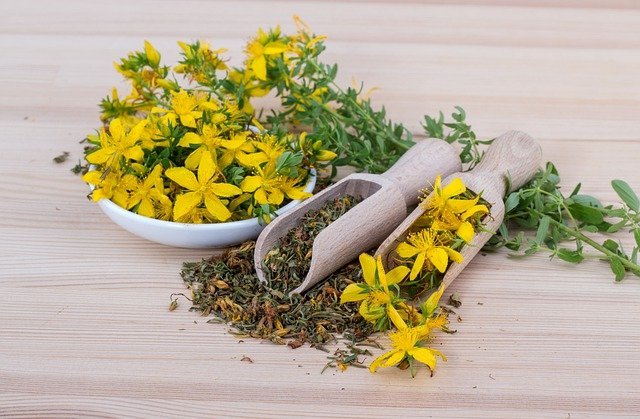
Hypericum oil is an oil lith that is obtained by macerate the fresh plant, flowers and leaves of Hypericum perforatum, in vegetable oil: olive oil, sunflower oil or almonds depending on the use of application that follows, for healing or cosmetic purposes. Let’s find out better.
Features of St. John’s wort oil
Hypericum oil has a very bright color of a beautiful bright and intense red given by a pigment called hypericin that is present in yellow flowers and leaves.
This characteristic is an excellent aid for the identification and collection of the plant, in fact it is sufficient to rub the leaves or flowers with the tips of the fingers to see the intense red of St. John’s wort oil appear and thus better identify the plant. The smell on the contrary does not help much being soft and poorly marked.
The Hypericum plant is called in the popular tradition scacciadiavoli precisely because already in ancient times they believed that this product removed the evils from both the physical and the energetic body. St. John’s wort oil is also called St. John’s Oil, and in fact the day of collection and preparation in the herbal tradition of the past was performed on June 24, the day dedicated to this saint. In the calendar June 24 is the summer solstice, the day when the sun is at its maximum splendor, and respecting the balsamic time of harvest at this time thus allows the influence of solar energy to be collected in the extraction of Hypericum oil. The preparation of the oleolite takes place by macerate the leaves and flowers for 21 days in oil inside a container; the difference from other oleolite is that the hypericum oil should be left exposed to the sun and not macerated in the dark.
The composition of this oillith is very wide and complex. A large part of the phytocomplex is extracted from the plant and this contains mainly: flavonoids (hypericin, rutin, hyperoside and quercetin), vitamins such as carotene (precursor of vitamin A), tannins and essential oil.
Properties and use of St. John’s wort oil
As an herbal remedy, Hypericum oil can be used directly on the skin in case of: bruises, sprains, skin spots, psoriasis, dryness, epidermal aging, sores, scars, stretch marks, wounds, cracks, hemorrhoids, insect bites, lesions caused by acne, wrinkles, sunburn or cold grazes, inflammation and infection of the skin (diaper redness), gingivitis, etc. …
This oil has healing, antiseptic (being antifungal and antiviral), astringent, decongestant, purifying, anti-inflammatory properties and is even able to stimulate cell regeneration.
The properties of promoting circulation, better spraying the capillaries, scarring and a strong antiseptic power, reveals how much this plant carries in itself remarkable abilities on the blood system and the intense red color becomes, according to the doctrine of paracelsus signatures, an excellent indicator of this healing property.
In addition to direct use on the skin, St. John’s wort oil is also used as a tincture or in the form of capsules. Internal use rebalances the sleep-wake rhythm and therefore is used as a remedy in cases of insomnia
For the nervous system, hypericum oil capsules with the addition of lecetin are indicated for cell regeneration of the central nervous system, in case of anxieties, tension or fatigue of mental origin can be used to restore rebalancing and general tone and mood.
For an emergency room in case of domestic burns it is possible to use St. John’s wort oil on the scalded part, but only after the heat has gone away from the affected part. It should never be used immediately because being in oily form would cause a frying effect. The first intervention must be to remove the heat from the affected part with cold water and then subsequently apply St. John’s wort oil as an excellent remedy to heal, flame, decongest and heal the sunburn.
As a cosmetic use it is therefore useful in different skin imperfections and used directly on the skin as an “unguneto” every evening and every morning reports excellent results already after 10 days of treatment.
We can also use it for massages especially when you feel joint pain, muscle contractures and you need heat. Also excellent in case of gout and rheumatism.
Did you know that
The use of St. John’s wort has an important warning to respect and that is not to expose yourself to the sun since it is photosensitizing. This means that if you use products based on St. John’s wort, both for oral and topical use, you should not expose yourself subsequently to the sun because dark spots and imperfections may appear on the skin.
An herbal recipe
To prepare the hypericum oillith it is necessary to obtain about 100 g of flowering tops of the plant collected starting from the end of June and in healthy, unpolluted soils.
The flowers and leaves are rinsed by quickly immersing them in a basin of water and gently dried in the air for a day on a cloth away from heat sources or direct light.
Inside a glass jar are added the flowering tops of St. John’s wort pouring over 500 ml of olive oil or almond or 400 ml of sunflower; The lid must be tightly closed and the pot is left to macerate exposed to the sun’s rays.
For the first 10 days the lid is opened to let out any air and condensation and then closes again, also the jar is turned up and down so that the plant is always beautiful covered with oil and well mixed. After 21 days, the contents are filtered by removing the grass and the oliolito, which has become a ruby red, is preserved in a glass container better if dark (brown or green) and well sealed.
The maceration time of 21 days depends very much on the climate and the temperature of the sun which must maintain at least 20 ° C daytime so it is recommended to leave the oil to macerate even for 30 days to extract all the active ingredients of the plant. In case you want to extract with sunflower oil, the period can reach up to 80 days to completely exhaust the extraction from the plant.






